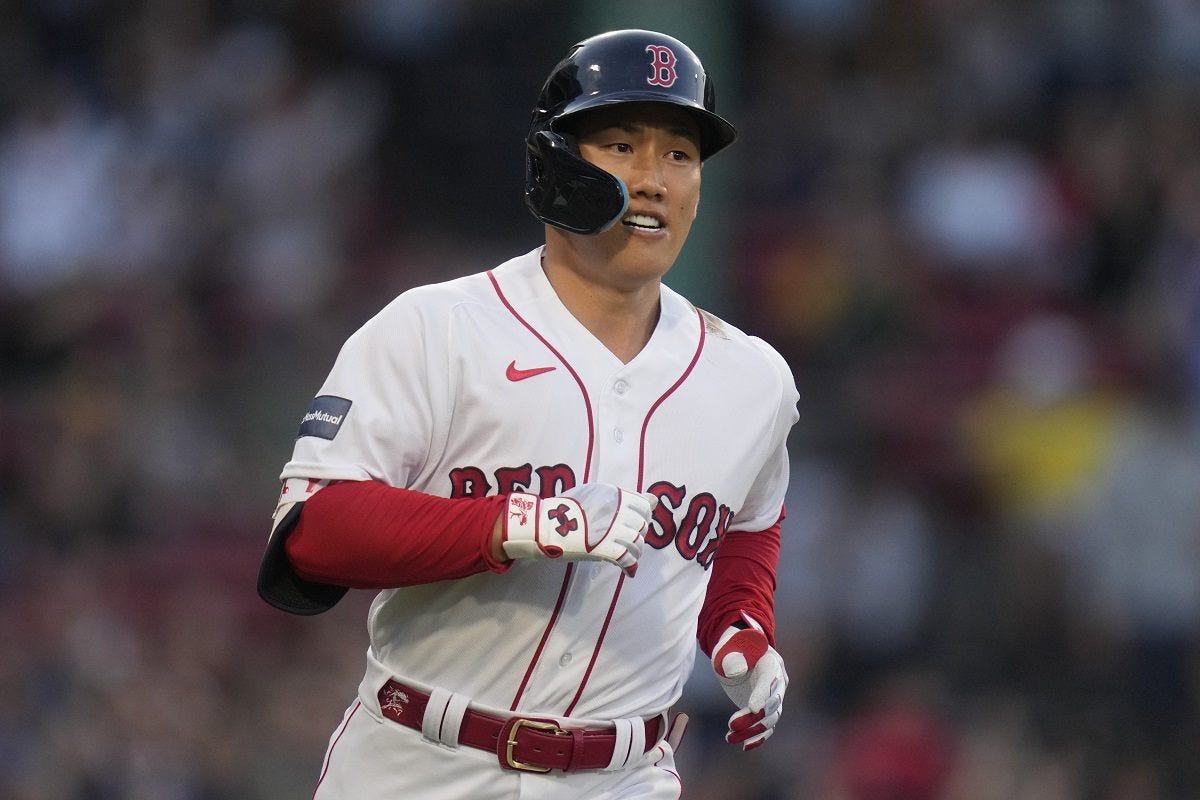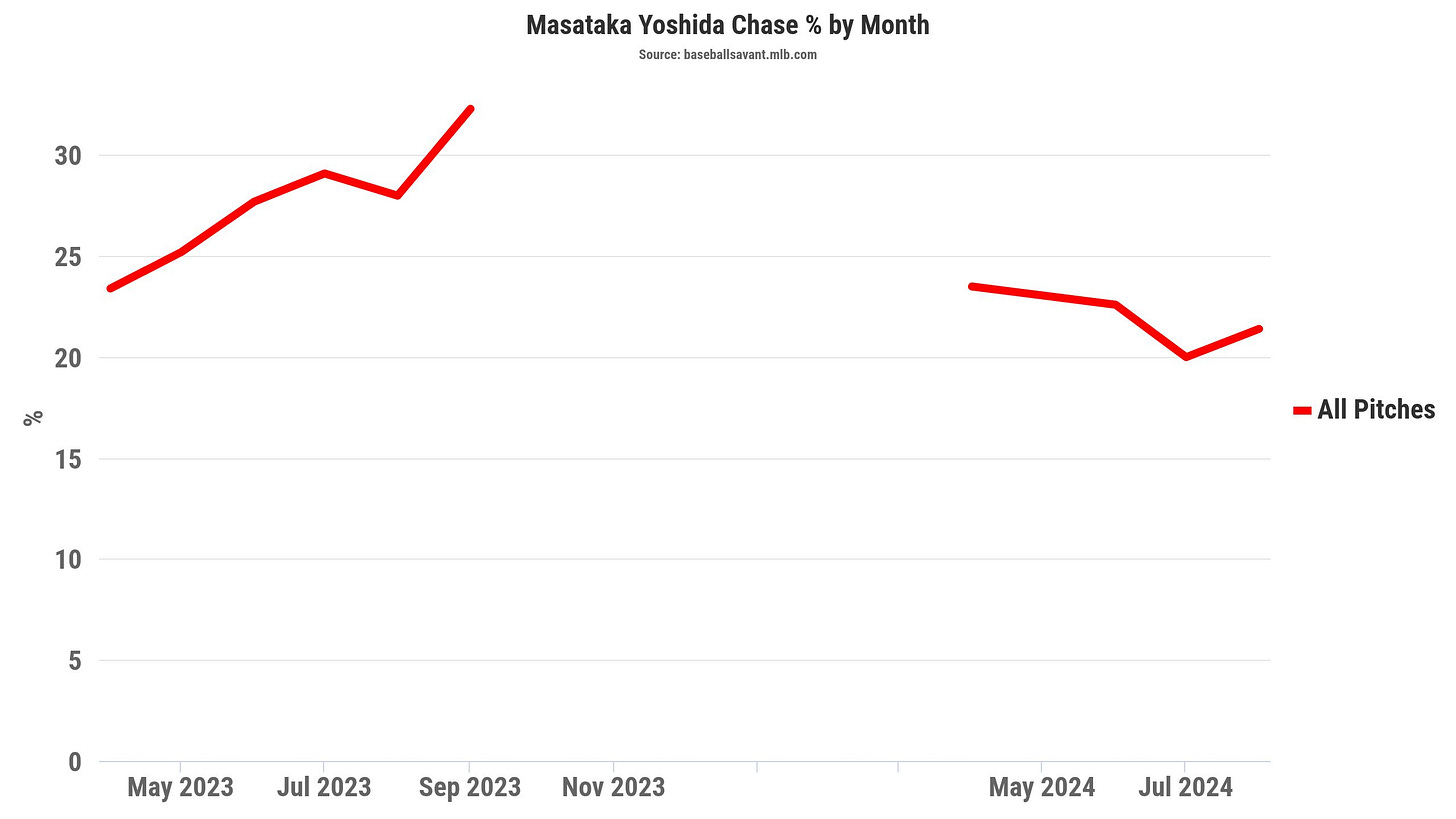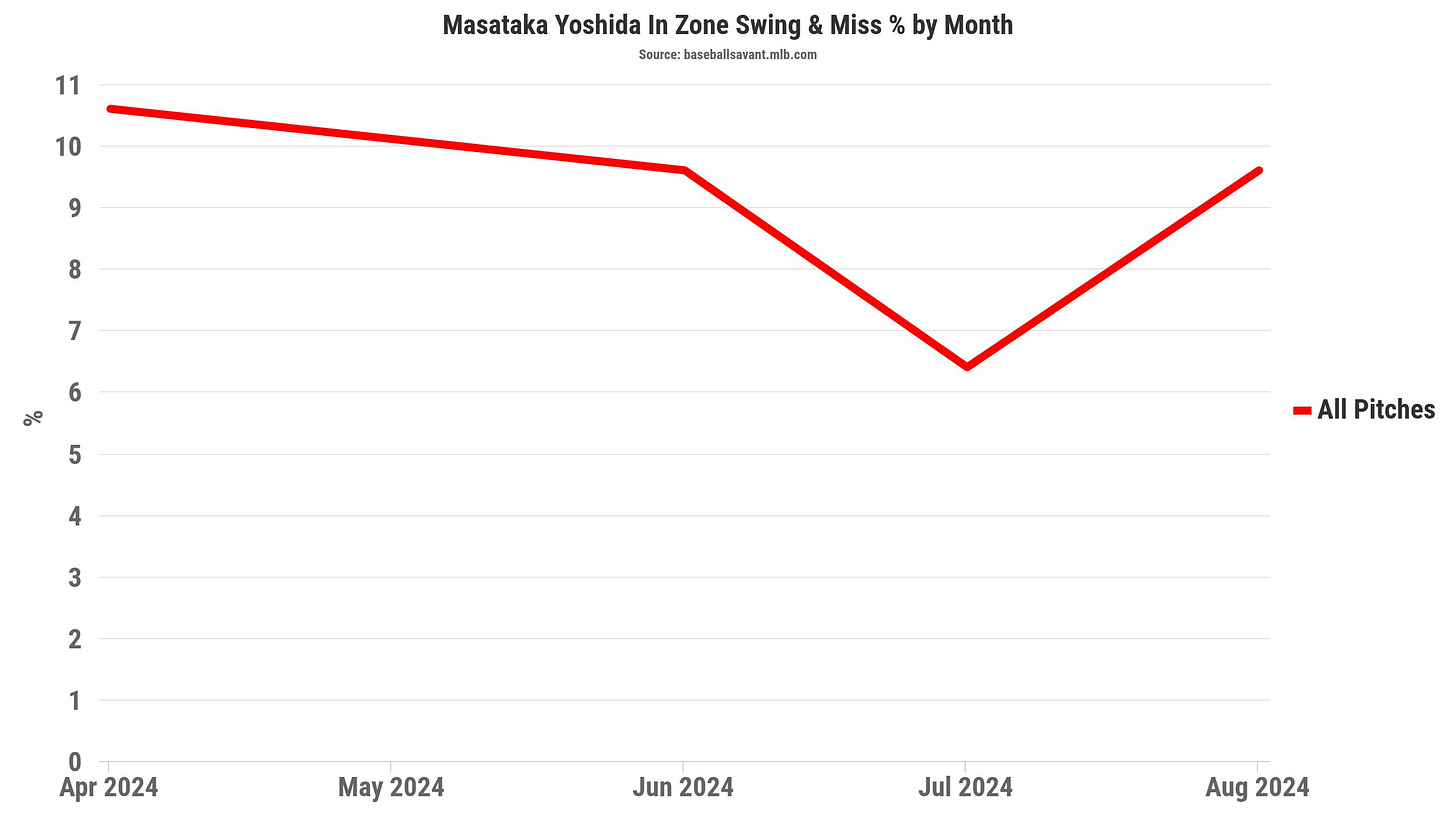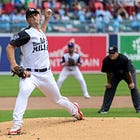Deep Dive: What's behind Red Sox' Masataka Yoshida's turnaround?
On June 22nd, 2024 the Red Sox had a Masataka Yoshida problem.
After a promising start to his first season in Boston, Yoshida’s offensive production had fallen off a cliff. Through July of 2023, Yoshida was living up to the expectations set by the 5-year, $95 million contract he signed that winter. To that point, Yoshida was slashing .304/.366/.481 with a 128 wRC+, meaning he had been 28% better than the league average at the plate. From August forward, however, Yoshida’s slash line fell to .257/.276/.371 with a wRC+ of just 68, putting him 32% below the league average in offensive production.
On that June 22nd night, the Red Sox's 77th game of the 2024 season and Yoshida’s 33rd after a left thumb strain cost him the entire month of May, Yoshida’s 0-4 performance dropped his season line to .228/.302/.316 and wRC+ to 72. In his last 307 plate appearances dating back to his August 2023 slump, he had slashed just .246/.287/.349 with a wRC+ of 70.
Yoshida sat out Game 78 vs Reds’ lefty starter Nick Lodolo before returning for Game 79 on June 24th vs Toronto and recording two hits. He hasn’t looked back since. In 160 plate appearances dating back to that June 24th night, he’s slashed .329/.400/.493 and recorded a wRC+ of 147. That wRC+ figure ties him with José Ramírez for 16th among qualified hitters in the American League over that span. His 150 wRC+ in July was the second-best month of his Major League career. Below are some of the things Yoshida has done better lately to achieve those marks.
Hitting the Ball in the Air
While searching for differences between his stellar July and the other months of his career, one thing stood out immediately. In the second-best month of his career, Yoshida’s HardHit% was actually the second worst it had ever been, at just 32.8% according to Baseball Savant. A ball is considered to be hard hit when it has an exit velocity of 95 mph or more. He was doing this less often and seeing vastly improved results, so was it just a fluke? Well, not exactly. Take a look at how Yoshida’s Barrel% has been trending:
A Barrel is a ball hit with at least a 98 mph exit velocity and a launch angle resulting in a batting average of at least .500 and a slugging percentage of at least 1.500. So, although Yoshida was hitting the ball hard less often, he was hitting the ball hard with the proper trajectory more often.
This checks out when looking at Yoshida’s LineDrive%, which was a career-high 32.8% in July. He’s hit more fly balls than line drives so far in August, but his GroundBall% remains lower than it was earlier this season, underscoring what appears to be a concerted effort to hit the ball in the air more often. The fact his Barrel% has continued to trend upward and his HardHit% has reached its season high in August suggests that he’s hitting balls in the air with more authority than he was before.
Improved Plate Discipline
One of Yoshida’s calling cards in Japan was his elite plate discipline, and that seems to have returned as well. Chasing pitches out of the zone was among the largest contributors to Yoshida’s slump at the end of 2023. From August through the end of the ‘23 season, Yoshida had a BB% of 2.8% and a K% of 18.8%. Before June 24th of this season, he was running a BB% of 6.3% and a K% of 12.7%. Though his K% is up to 14.4% so far during the turnaround, his BB% is all the way up to 8.1%. You can see in the chart below that he’s chasing less overall this season and that his offensive production often goes as his chase does.
Striking Out…More?
This is also an example of a phenomenon that drives much of the disconnect between the statistical and traditional communities, where striking out a little more can sometimes be a good thing. Check out the three charts below, with Yoshida’s K%, ChaseMiss%, and In-ZoneMiss%, by month of the season, keeping in mind that July was one of the best months of Yoshida’s career:
If there were ever a recipe for a beneficial increase in strikeouts, these would be the ingredients. We’ve already established that Yoshida hasn’t been chasing many pitches out of the zone — he’s in the 87th percentile overall this season in Chase%. July was his best month of the season in terms of In-ZoneMiss% suggesting the extra strikeouts weren’t coming from there either. What was really behind that increase in K% was that he was missing more of the few pitches he was chasing out of the zone, limiting some of the out-of-zone contact that was likely leading to worse batted-ball outcomes.
This is not the same formula that led to the 18.8% K-rate he ran late last year by chasing too much, but rather the result of an approach meant to make contact on the right pitches. That Yoshida has been a tad worse in August while each of these metrics has reverted likely isn’t mere coincidence. He’s still doing a good job of barreling the ball and keeping it in the air, however, and the August sample size is smaller, meaning we could still see movement in one direction or the other before the month is out.
Crushing Fastballs
The last thing I looked at was what pitches Yoshida saw the most improvement on, and the answer was resoundingly fastballs. July and August have been Yoshida’s best career months against the fastball, with xWOBAs of .395 and .386 respectively on the pitch. These are much closer to — and even surpass — the marks that Yoshida was putting up on fastballs during his early run of success in 2023. It leads one to wonder how much health has to do with Yoshida’s struggles.
Much was made of Yoshida’s transition to the more grueling MLB schedule from the one he was used to during his years in the NPB. In the offseason, we learned that Yoshida underwent surgery on his jaw and that he found it difficult to hit with the ailment constantly nagging him late in last season. We also mentioned his thumb injury from earlier this year. The fact he’s been able to catch up to and turn around velocity at a higher level recently could be an indicator that he’s feeling strong and the health issues are behind him.
Is Yoshida Back in the Long-Term Plan?
In summary, Yoshida has turned around his season by hitting more balls in the air, making better swing decisions, making more contact on the pitches he should and less on pitches he shouldn’t, and by catching up to the fastball perhaps by virtue of better health. This is all very encouraging and feels repeatable, but despite the improved performance, the Red Sox will still have difficult decisions to make this offseason with their logjam of lefty-hitting outfielders. They may still deem Yoshida the odd man out with his lack of versatility, but it does seem like less of a foregone conclusion thanks to his turnaround.
He’s making the decision more difficult each day by proving how lethal he can be as a hitter, and he’ll be a key figure in the team’s pursuit of a playoff position for the rest of this year. His contract has made him the subject of constant conversation and his doubters have wondered whether he can play up to the hefty price tag. You can count me among the doubters he is proving wrong with this run.
Red Sox ‘close’ to finalizing minor-league deal with veteran southpaw
There are three guarantees in life: death, taxes, and Rich Hill pitching for the Boston Red Sox.










